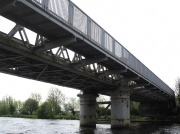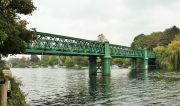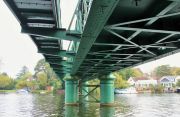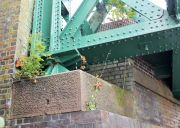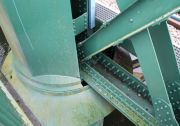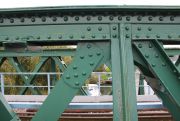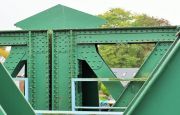Bourne End Railway Bridge
Bourne End Railway Bridge is a railway bridge carrying the Marlow Branch Line, and a footpath over the River Thames in Bourne End, Buckinghamshire. It crosses the Thames on the reach between Cookham Lock and Marlow Lock.
The bridge was originally constructed in wood by Isambard Kingdom Brunel as part of the Wycombe Railway, opened in 1854 and operated in broad gauge until 1870.
The narrow spans were unpopular with river traffic and it was reconstructed in iron and steel in 1895. The Chief Engineer was James Charles Inglis.
A footbridge, cantilevered out from the railway bridge was added in 1992, to take the Thames Path across the river.
1896 Report: 'THE NEW VIADUCT OVER THE RIVER THAMES AT BOURNE END.
The boating fraternity — as well as railway travellers — will observe with much satisfaction that the old, unsightly and obstructive wooden railway-bridge at Bourne End has at last given place to an attractive substantial iron viaduct, one of the best of its kind on the river Thames. The work of building the bridge was commenced in July, 1894, and the viaduct was opened for railway traffic in October, 1895. It carries a single line of railway, but is so designed that this can be doubled when found necessary. On the Berks shore there are five brick arches, terminating in a substantial abutment, which supports the girders. The river is crossed by three spans of lattice girders, the river piers being formed of iron cylinders filled with cement concrete and carried well down into the chalk to a depth of about 20 feet below the bed of the river. They were sunk by the pneumatic process, which consists of pumping air into the cylinders in order to expel the water during the sinking operations. The spans of the girders, which are made of steel, are in each case 98 ft. 6 in., those on the east side being made of double strength to serve as central girders for a double line of railway. The total weight of iron and steel in the structure amounts to 330 tons. The viaduct terminates on the Bucks shore with two brick arches and heavy abutments. The progress of the work was much hindered by the exceptional floods of November, 1894, when the water rose to six feet above summer level, and also by the severe frosts which occurred during January and February, 1895. The work was examined and tested by Colonel Yorke, of the Board of Trade, on 16th December, 1895, and it was found that the deflection of the girders, under a load of 120 tons, did not exceed three-eighths of an inch. As soon as the new viaduct was opened for public traffic, the demolition of the old structure was commenced, and as all the piles, about 60 in number, were drawn, the river presents now an uninterrupted waterway 90feet wide through the centre opening. The work was carried out for the great Western Railway Company by Mr. F. C. Caffin, of Marlow, the girders and cylinders being supplied by the Cleveland Bridge and Engineering Company, of Darlington.' [1]
See Also
Sources of Information
- ↑ Maidenhead Advertiser - Wednesday 22 April 1896
- [1] Wikipedia


